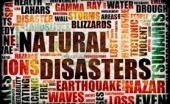Re The UN General Assembly Speaker Schedule is Here! I note that whoever will be speaking for Canada this year…
Climate change, natural disasters September 2024-
Written by Diana Thebaud Nicholson // November 9, 2024 // Climate Change, Natural Disasters // No comments
the International Disaster Charter website
NASA Applied Science Disasters website
UNDRR [UN Office for Disaster Risk Reduction]’s Work Programme for 2024-25 comes at a critical juncture. It is built around strategic objectives that are geared to helping countries better understand the risks they face and to strengthen their disaster risk governance at all levels; to driving up investments in disaster risk reduction through stakeholder partnerships; and to integrating disaster risk reduction at the heart of sustainable development efforts.
There’s nothing natural about disasters. In fact, contrary to popular perception, we are far from powerless in the face of earthquakes, tsunamis, cyclones and pandemics. Such hazards may be inevitable, but their disastrous impacts are not: we can curb their devastating power by understanding their interrelated risks, setting up early warning systems and investing preemptively
Doing so is becoming ever more urgent as the accelerating pace of climate change causes more frequent longer-lasting and harsher weather events, and as many countries urbanise at unprecedented rates.
16 August 2021
How Indigenous knowledge could help manage wildfire risk
(WEF) For many ecosystems, fire plays a key role in supporting and maintaining biodiversity.
For thousands of years, Indigenous people have purposefully used fire to shape the landscapes they inhabit.
A new study has found that Indigenous fire stewardship increases biodiversity in almost all of Earth’s terrestrial biomes.
Biodiversity keeps ecosystems more resilient to disturbances and provides immeasurable intrinsic, recreational and societal value.
8 August 2021
How Indigenous burning practices can help curb the biodiversity crisis.
9 November
We can prepare for hurricanes, heatwaves and flooding – but only if we are bold at Cop29
Ban Ki-moon
The right funding now can protect the frontlines of the climate crisis from the worst effects of extreme weather events
30 October
Spain’s ‘monster’ floods expose Europe’s unpreparedness for climate change
National government blamed local authorities after at least 92 people died as heavy rainfall swept through homes, shops and roadways.
(Politico Eu) Spain’s deadliest floods in decades are another harrowing reminder that Europe is unprepared for the consequences of a superheated atmosphere, said European Commission President Ursula von der Leyen on Wednesday. …
In recent weeks, several European countries have been hit by deadly and damaging floods. And floods in Greece, Belgium and Germany in the past few years served as further warnings about the increasing danger of extreme weather.
The fingerprint of climate change on the storm that hit Spain this week has not yet been measured. But scientists said Wednesday that warming was a key factor. The Mediterranean Sea broke all-time temperature records in August. That would, in turn, have led to more water being carried up into clouds.
Spanish floods kill 95 as year of rain falls in a day in Valencia
Europe’s deadliest floods since 2021, could be Spain’s worst
Death toll could still rise with more searches on Thursday
Roads closed, rail services halted
Storm also batters other regions
Farms battered in Valencia, a key orange producer
(Reuters) – At least 95 people have been killed in possibly the deadliest flooding to hit Spain in its modern history after torrential rain battered the eastern region of Valencia, sweeping away bridges and buildings, local authorities said on Wednesday.
Meteorologists said a year’s worth of rain had fallen in eight hours in parts of Valencia on Tuesday, causing pile-ups on highways and submerging farmland in a region that produces two-thirds of the citrus fruit grown in Spain, a leading global exporter.
14 October
Colonial solutions to climate change aren’t working
What Indigenous knowledge could mean in the fight to curb global warming.
(Vox) …today, on Indigenous Peoples’ Day, we’ve published the project’s latest feature, a story that takes us to Idaho, where the Coeur d’Alene Tribe is undergoing a sweeping, multi-decade effort to restore an important wetland on the reservation. Their restoration, guided by the return of ancestral food sources, could serve as a model for the rest of the country.
Stories like the Coeur d’Alene’s highlight the value of Indigenous solutions as we face increasingly extreme weather and natural disasters and navigate the brutal effects of the climate crisis.
Around the world, Indigenous people have the smallest carbon footprint, according to the United Nations, but are more vulnerable to the impact of climate change because they disproportionately live in geographically high-risk areas.
At the same time, these communities are also key sources of knowledge and understanding on climate change impacts, responses, and adaptation. Their traditional knowledge — focused on sustainability and resilience, from forecasting weather patterns to improving agricultural practices and management of natural resources — has increasingly gained recognition at the international level as a vital way to tackle climate change.
The tiny potato at the heart of one tribe’s fight against climate change
Wetlands absorb carbon from the atmosphere. The Coeur d’Alene’s restoration would do more than just that.
13 October
Climate Disasters Only Slightly Shift the Political Needle
Researchers tracking the social and political impacts of storms, floods and heat waves say their effects are often transient and short-lived.
Even amid what seems like a never-ending series of deadly and destructive climate extremes across the country, including heat waves in the Southwest, wildfires in California and hurricanes and flooding in the Southeast, social and political scientists say climate is still not a major issue for U.S. voters. Despite the deaths and destruction that Hurricanes Milton and Helene inflicted on North Carolina and Florida just a month before Election Day, the storms are unlikely to swing many votes, the researchers report.
“I watched for many years the hypothesis that hurricanes or other events would move the needle on public opinion, but saw little evidence of response to individual events,” said Lawrence Hamilton, a professor of sociology at the University of New Hampshire who researches public views of science, the environment, climate change and human-environment interactions.
He said there was a slow upward trend in climate awareness and response through 2020 that may have been interrupted by the COVID pandemic, but he said the data suggests that single extreme events did not have much of an effect on voters.
12 October
Climate Change Made Hurricane Milton Stronger, With Heavier Rain, Scientists Conclude
A rapid analysis of rainfall trends and Gulf of Mexico temperatures shows many similarities to Hurricane Helene less than two weeks earlier.
Even though climate change may not be increasing the average number of storms in a season, there is evidence indicating the percentage of total storms reaching Category 4 is increasing, consistent with most climate modeling studies.
3 October
Why Helene Caught So Many Residents Off Guard
As the process of rebuilding begins, many survivors face an expensive obstacle: a lack of flood insurance.
Western North Carolina lies hundreds of miles inland from any coast. The counties around the Blue Ridge Mountains sit at high elevations, away from the dense flood zones along the Atlantic. The idea that more than a foot of rain would rapidly overwhelm the region, sweeping up homes and ripping up vegetation, seemed almost unthinkable. But a week after Hurricane Helene made landfall, at least 200 people have died, and the death toll is expected to rise as the floodwaters recede and the debris clears.
1 October
How Climate Change Intensified Helene and the Appalachian Floods
Rain just before the storm set the stage for a catastrophe.
8 September
‘Beautiful in its own way’: New forest emerges in Jasper National Park, bringing protection and new opportunities
(CTV Edmonton) Things are starting to look green again in Jasper.
Charred stumps and the remains of fire-ravaged trees still cover large tracts of land on the Jasper landscape, but life is returning quickly down below.
“This fire has even surprised me as a fire ecologist, with how quickly a lot of the ground cover has already started to come back,” said Landon Shepherd of Parks Canada.
“Even in the very severely impacted sites, both the rhizomes and the more extensive root systems of some of the trees and shrubs that were removed have already started to sprout pretty vigorously.”
The Jasper fire started as multiple fires that merged into one as they rippled through the forest, which was the driest it had been since the park began recording at the current weather station in 1962.
“In the last five years, we’ve been averaging two to four days of when we’ve been in extreme (conditions) during the entire fire season,” Shepherd said. “Leading up to this fire, we were in over two weeks of extreme.”
The fire was so intense it created its own weather system with winds powerful enough to toss a shipping container at the Wabasso Campground into the Athabasca River near the Wabasso Campground.
2-8 September
For the thirty-sixth week of 2024, the ASEAN region experienced 20 significant disasters, including floods, landslides, storms, and strong winds. Indonesia, the Philippines, and Viet Nam were affected by these disasters. The Badan Nasional Penanggulangan Bencana (BNPB) of Indonesia reported flooding and strong winds in West Java, Jambi, Central Sulawesi, and North Sumatra. In the Philippines, the National Disaster Risk Reduction and Management Council (NDRRMC) reported the flooding, storms, landslides, and strong winds from Week 1, which had affected Regions I, II, III, CALABARZON, V, VI, VII, VIII, CAR, and NCR. Lastly, the Viet Nam Disaster and Dyke Management Authority (VDDMA) reported flooding, landslides, storms, strong winds, and storm surge in the Northern Region.
4 September
Climate summit opens in Kenya as Africa demands more say and financing
African leaders are determined to wield more global influence and have the world’s biggest greenhouse gas emitters pay their fair share.
(Al Jazeera) More than a dozen heads of state of African countries are due to attend the first African Climate Summit as the continent seeks to assert a stronger voice on a global existential problem that it contributes the least to.
Kenyan President William Ruto’s government and the African Union launched the meeting on Monday in Nairobi, determined to wield more global influence and bring in far more financing and support.
“We have an abundance of clean, renewable energy, and it’s vital that we use this to power our future prosperity. But to unlock it, Africa needs funding from countries that have got rich off our suffering,” Mohamed Adow with Power Shift Africa said before the summit.
Meanwhile, the advocacy group ONE campaign warned in a report released ahead of the summit that high-interest rates and lack of sufficient capital from bodies like the World Bank have made debt increasingly unsustainable for low-income countries and have held up financing for much-needed climate solutions.


